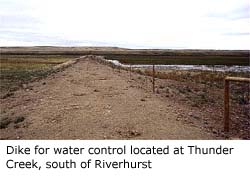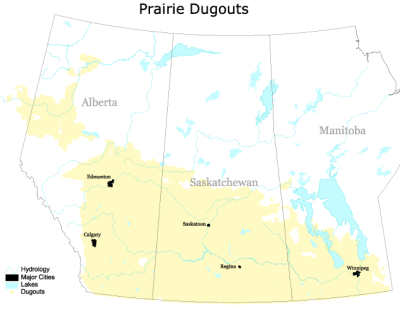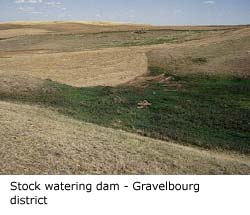

The two most common water projects built to meet farm requirements are the dugout (farm pond) and dam. On most prairie farms, wherever land with sufficient drainage area slopes toward a central or focal point in a field, suitable sites for small, waterstorage projects can be found. Such storages make dependable farm water supplies possible for domestic, stock-watering and irrigation purposes.
Under prairie conditions of sun and wind, water supplies stored in surface reservoirs, when properly located and managed, can provide good quality water superior to that obtained from local wells. The most common type of reservoir used for water storage on the prairie farm is the dugout, consisting of a simple excavation in the ground located in a watershed area. Most farms have one or more suitable sites where dugouts can be located.
In many parts of western Canada, dugouts provide the main source of farm water supply. The basic conservation measure of trapping and holding melting snow can provide livestock and farm water needs. In the past, many farm dugouts were constructed solely as an emergency water supply for drought conditions. Today, dugouts are generally relied upon to provide a continuing water supply and thus must be large enough to provide this supply on a regular annual basis through dry years in a drought prone region.
During drought years, many dugouts were left with dangerously low levels of water. Pumping or recharging from other surface sources became a common practice to solve water shortages. The drought year of 1961 was one such year which prompted PFRA to acquire pumping equipment to meet the emergency. Trailers of pipe along with pumps moved across Saskatchewan and Manitoba recharging dugouts. In 1972, Saskatchewan took over the dugout pumping in that province and Manitoba followed shortly thereafter. Each of the three provinces currently has its own dugout pumping program, recognizing that pumping is an alternative to source development. In fact in some cases, pumping may be the only alternative. During drought years, more dugouts would be pumped if water supplies were available as pumping sources. Sometimes a lack of pumping sources result in farmers hauling water, moving cattle or simply abandoning the source until runoffs re-occur.
By 1996, water development activities shifted focus to improving use of existing water sources,
by improving the water quality in dugouts and increasing yield and water quality in wells.

Dugouts are usually located slightly off a main water course to avoid spillway problems. When a dugout is full, the flow carries on down the channel without depositing additional silt in the dugout. To utilize the water from the dugout, a pipe from the lower level to a well, or to a well and filter, proves satisfactory for domestic and livestock use as well as for irrigation. The dugout can be protected by a good fence to prevent contamination of the water and danger to humans or farm livestock.
Prairie soils are usually suitable for construction of reservoirs since they contain a high percentage of clay. Prior to the construction of a dugout or dam, it is advisable to test the proposed site for excessive seepage.
Runoff from approximately 50 acres of prairie field is normally sufficient to maintain the supply required for the average prairie farmstead for three years without replenishing. The average farm dugout is 200 feet by 70 feet on the surface, with 1 1/2 to 1 slopes on the sides and 4 to 1 slopes on the ends. It is at least 12 feet deep - preferably 15 or 16 feet. The volume of excavation is between 3,500 and 4,500 cubic yards. The water capacity is 2 to 3 acre feet more than 1 1/2 million gallons. Large dugouts were excavated whenever the local drainage area produced more water and wherever the additional quantity could be utilized by a farmer, or by a community, provided the soil had a satisfactory water-holding capacity.
Farm reservoirs were constructed by farmers or ranchers themselves. Beginning in 1935, farmers were offered a subsidy of up to $50 to build dugouts through the Rural Water Development Program (RWDP). To qualify for the money, the dams and dugouts had to be build to certain standards. They were intended to provide at least a two-year water supply and were designed to be 4 to 5 meters deep to minimize evaporation.
The rate of assistance paid on individual projects has varied from time to time and is based on yardage of earth moved. In 1936, farmers were paid up to $50 for dugouts; In 1946, this was increased to $125; in 1959, to $250 and in 1973 to a maximum of $550. In 1973, a farm wells program was introduced. In 1981, farmers would receive up to $1500 for dugouts and this amount was again increased to $1650 in 1982. The present rate is $7 per cubic yard up to a maximum of $250 in the case of dugouts, $300 for stockwatering dams, and $600 for irrigation projects. Where two or more farmers pool their water resources to build neighbor projects, assistance is paid to a maximum of $1,000.
Most farmers lacked the proper equipment to do the job, and in the first year of the program only 49 dugouts were completed. When the subsidy was increased, it became economical for farmers to pay contractors equipped with draglines to do the work that was beyond their ability. Over 148,417 individual farmsized dugouts and 14,839 stockwatering dams have been built during the past 25 years. This has been a significant contribution to prairie agriculture.
Since 1935, the majority of water supply projects have been dugouts. In his book, Man against the Desert, prairie historian James H. Gray paid tribute to the dugout when he wrote,
"The dugouts were as inelegant a collection of holes in the ground as ever devised by man. They did nothing aesthetically for the landscape. They were utilitarian in the extreme. Yet, if acceptance is a measure of worth, few more valuable projects were ever devised."The Federal Department of Agriculture continues to assist farmers by providing free engineering and/or agricultural services as well as cash grants on projects constructed to satisfactory standards.


Where topography was suitable, small dams were constructed across coulees, gullies or
watercourses to
catch and store spring runoff. Such structures made effective water storage facilities. Stock
watering
dams were constructed in creek beds, coulees, draws and gullies which lend themselves to this
type
of
construction and had a drainage area sufficient to ensure filling from spring runoff under normal
snowpack conditions. Financial assistance was based on the amount of earth and rock required to
construct such projects.